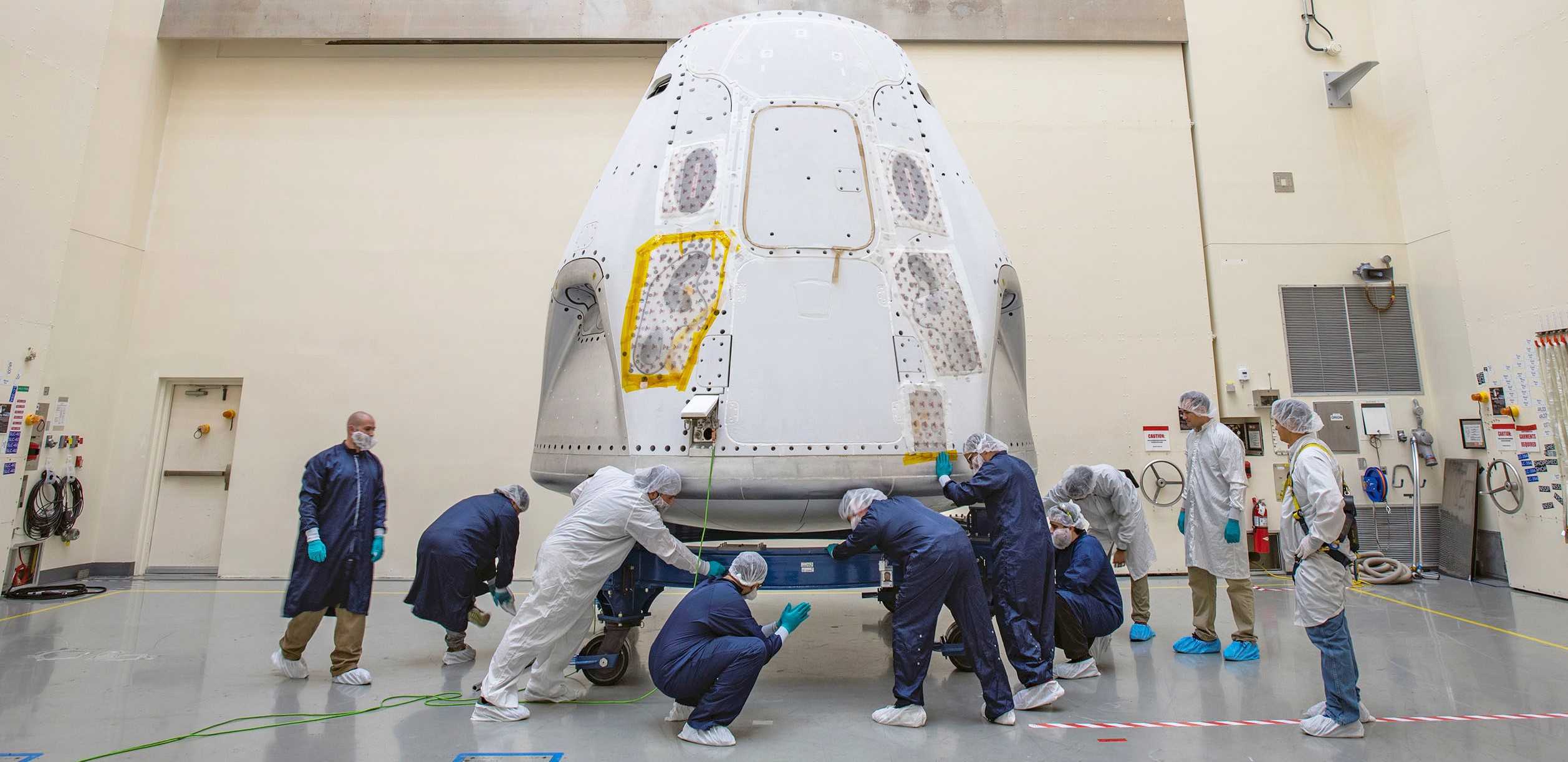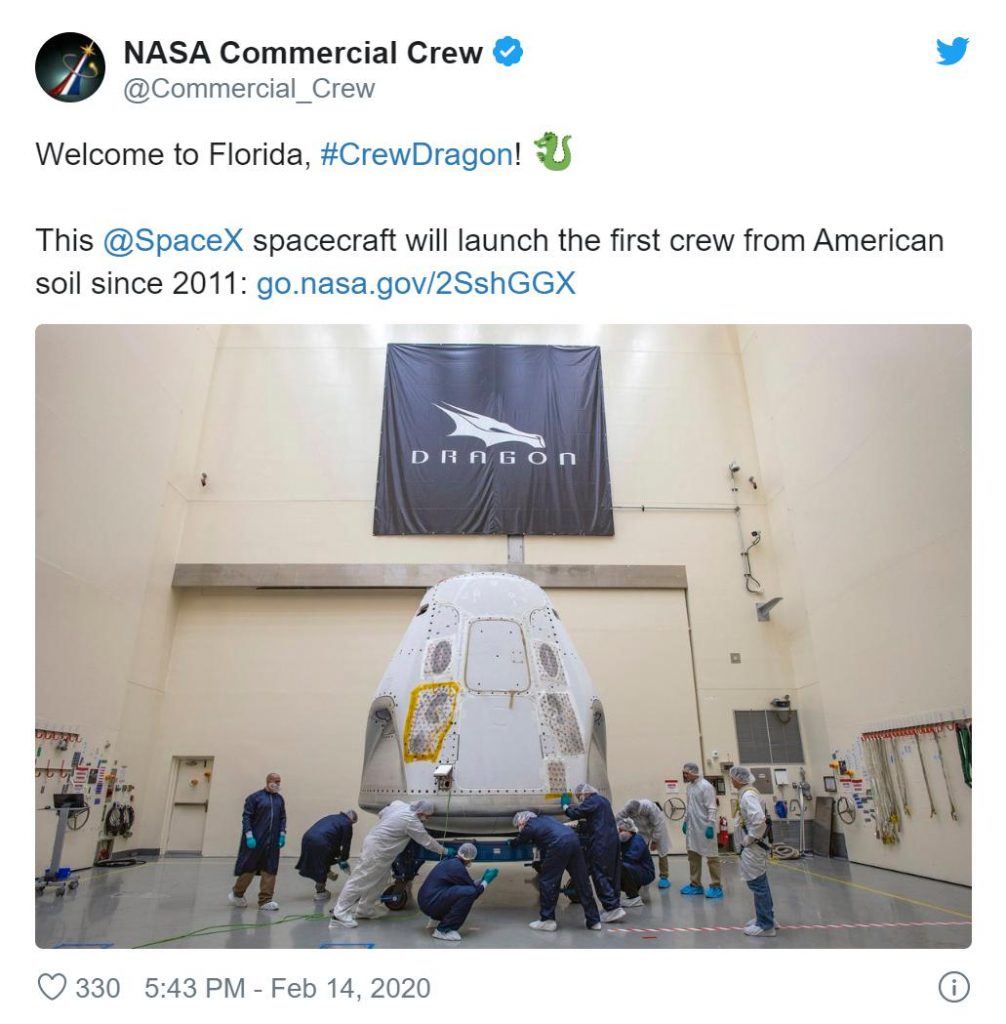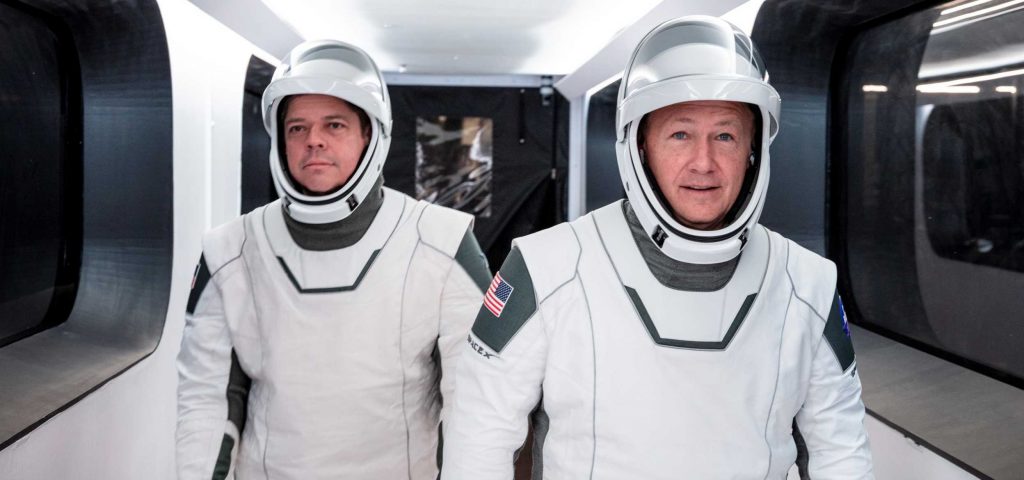

News
NASA confirms SpaceX will become the first private company to send astronauts to the space station
NASA has unambiguously confirmed that SpaceX – with its Crew Dragon spacecraft – will soon become the first private company in history to launch astronauts to the International Space Station (ISS), both an unexpected twist from the usually tight-lipped space agency and a major upset for Boeing.
Shortly after revealing that the first astronaut-rated Crew Dragon capsule had been completed and shipped eastward, SpaceX and NASA confirmed that the historic spacecraft arrived at SpaceX’s Florida processing facilities on Thursday, February 13th. With that milestone out of the way, it’s now believed that all the hardware needed for SpaceX’s ‘Demo-2’ astronaut launch debut – Falcon 9 booster B1058, a Falcon 9 upper stage, Crew Dragon capsule C206, and a Crew Dragon trunk – is finished, acceptance-tested, and preparing for flight in Cape Canaveral, Florida.
Extremely out of character for NASA given that Crew Dragon Demo-2 is expected to launch no earlier than two or three months from now, the space agency’s public statement that SpaceX will launch astronauts first simultaneously implies bad news for Boeing and its Starliner spacecraft. Contracted under the Commercial Crew Program in 2014, Boeing – awarded $5.1B – and SpaceX – awarded $3.1B – have been working to build two separate crew launch vehicles (Starliner and Crew Dragon) with the intention of ferrying NASA astronauts to and from the International Space Station (ISS). While both providers have had their own challenges, Boeing has been beset by numerous software failures born out during Starliner’s December 2019 orbital launch debut.

The Commercial Crew account has since deleted its tweet and NASA’s accompanying blog post – linked in said tweet – was tweaked to reflect a slightly different interpretation, but the original text unequivocally stated that “the SpaceX Crew Dragon spacecraft [assigned to] the first crew launch from American soil since 2011 has arrived at the launch site.” Given that both the tweet and blog post contained that exact same phrase, the fact that NASA retroactively censored and corrected itself strongly suggests that SpaceX will, in fact, become the first private company in history to launch astronauts into orbit.
NASA has a fairly notorious and years-long history of going well out of its way to avoid saying or implying anything that could be perceived as even slightly critical of Boeing. A prime contractor dating back to the first stage of the Saturn V rocket, Boeing has effectively secured billions of dollars of NASA’s annual budget and possesses deep political sway thanks in large part to the revolving doors between industry and government and the hundreds of millions of dollars it has spent on lobbying over the last two decades.
More recently, Boeing’s Starliner spacecraft suffered several major software-related failures during its December 2019 Orbital Flight Test, narrowly avoiding a second “catastrophic” failure mode solely because a separate software failure 48 hours prior forced the company to reexamine its code. In simple terms, both software failures probably should and could have been caught and fixed before launch if even a semblance of routine digital simulations and integrated vehicle testing had been performed by Boeing.
Unsurprisingly, NASA – at least after the fact – is now extremely concerned by the lack of such a basic and commonsense level of quality control in Boeing’s Starliner software pipeline. Even NASA, arguably, could and should have been attentive enough to catch some of Boeing’s shortcomings before Starliner’s launch debut. Adding to the embarrassment, NASA performed a “pretty invasive” $5M review of SpaceX’s safety practices and general engineering culture last year, triggered (not a joke) after CEO Elon Musk was seen very briefly smoking on a recorded interview. As part of regulations for the Commercial Crew Program, NASA was obligated to perform a similar review of Boeing’s safety culture, but the contractor demanded that NASA pay five times more – $25M – for the same thing.

NASA unsurprisingly balked at Boeing’s demands and wound up performing a more or less symbolic “paper” review that typically involves ‘auditing’ paperwork supplied by the company itself. Despite the fact that Boeing would soon find itself mired in two fatal 737 Max crashes, killing 346 people as a result of shoddy software, an unreliable design, and bad internal communication, NASA still never pursued a similar safety review with Boeing. Now, only after a nearly-catastrophic in-space failure, NASA has finally decided that that safety review is necessary, while both NASA and Boeing will also have to extensively review all Starliner software and fix the flawed practices used to create and qualify it.
Perhaps most importantly, NASA and Boeing need to determine whether Starliner’s software failures were a one-off fluke or something symptomatic of deeper problems. Due to that uncertainty and the massive amount of work that will be required to answer those questions, it’s almost certain that Boeing will have to perform a second uncrewed Starliner test flight for NASA to verify that its problems have been rectified. A second OFT would almost certainly delay Boeing’s astronaut launch debut by 6-12 months. SpaceX’s astronaut launch debut, for example, was delayed at least 9 months after a Crew Dragon capsule exploded during thruster testing after a flawless orbital launch and recovery.

As a result, even though SpaceX’s Crew Dragon ‘Demo-2’ astronaut launch debut is likely more than two months away, even some part of NASA – famous for incredibly neutral and conservative public statements – appears to be all but certain that SpaceX will launch astronauts first. As of February 13th, 2020, all Demo-2 Falcon 9 and Dragon hardware is likely finished and awaiting integration in Florida. If things go as planned over the next several weeks, Falcon 9 and Crew Dragon could launch astronauts Bob Behnken and Doug Hurley as early as late-April or May 2020.
Check out Teslarati’s Marketplace! We offer Tesla accessories, including for the Tesla Cybertruck and Tesla Model 3.
News
SpaceX’s Crew-11 mission targets July 31 launch amid tight ISS schedule
The flight will lift off from Launch Complex 39A at Kennedy Space Center in Florida.

NASA and SpaceX are targeting July 31 for the launch of Crew-11, the next crewed mission to the International Space Station (ISS). The flight will lift off from Launch Complex 39A at Kennedy Space Center in Florida, using the Crew Dragon Endeavour and a Falcon 9 booster.
Crew Dragon Endeavour returns
Crew-11 will be the sixth flight for Endeavour, making it SpaceX’s most experienced crew vehicle to date. According to SpaceX’s director of Dragon mission management, Sarah Walker, Endeavour has already carried 18 astronauts representing eight countries since its first mission with NASA’s Bob Behnken and Doug Hurley in 2020, as noted in an MSN report.
“This Dragon spacecraft has successfully flown 18 crew members representing eight countries to space already, starting with (NASA astronauts) Bob (Behnken) and Doug (Hurley) in 2020, when it returned human spaceflight capabilities to the United States for the first time since the shuttle retired in July of 2011,” Walker said.
For this mission, Endeavour will debut SpaceX’s upgraded drogue 3.1 parachutes, designed to further enhance reentry safety. The parachutes are part of SpaceX’s ongoing improvements to its human-rated spacecraft, and Crew-11 will serve as their first operational test.
The Falcon 9 booster supporting this launch is core B1094, which has launched in two previous Starlink missions, as well as the private Ax-4 mission on June 25, as noted in a Space.com report.
The four-members of Crew-11 are NASA astronauts Zena Cardman and Mike Fincke, as well as Japan’s Kimiya Yui and Russia’s Oleg Platonov.
Tight launch timing
Crew-11 is slated to arrive at the ISS just as NASA coordinates a sequence of missions, including the departure of Crew-10 and the arrival of SpaceX’s CRS-33 mission. NASA’s Bill Spetch emphasized the need for careful planning amid limited launch resources, noting the importance of maintaining station altitude and resupply cadence.
“Providing multiple methods for us to maintain the station altitude is critically important as we continue to operate and get the most use out of our limited launch resources that we do have. We’re really looking forward to demonstrating that capability with (CRS-33) showing up after we get through the Crew-11 and Crew-10 handover,” Spetch stated.
Lifestyle
EV fans urge Tesla to acquire Unplugged Performance for edge in fleet and security industry
Unplugged Performance has built a name for itself by producing performance upgrades for Tesla vehicles.

A growing number of Tesla enthusiasts and longtime community voices are calling on the electric vehicle maker to acquire Unplugged Performance, a California-based aftermarket company best known for tuning Tesla vehicles and developing specialized government fleet solutions under its UP.FIT division.
The idea was once considered a niche proposal among EV fans, but it is now gaining serious attention not just as a performance play but as a strategic move to deepen Tesla’s roots in the fleet and security industry.
A strategic fit
Unplugged Performance has built a name for itself by producing performance upgrades for Tesla vehicles, from track-optimized components to visual and aerodynamic upgrades. But in recent years, its UP.FIT division has pivoted toward a more functional future by outfitting Tesla vehicles like Model Ys for police, military, and government use.
That work has sparked growing calls for closer collaboration with Tesla, especially as the EV maker increasingly leans into autonomy, AI, and fleet services as core components of its next chapter.
“I posted this four years ago, but I think it’s more true now than ever,” wrote Whole Mars Catalog, a well-known Tesla investor and FSD Beta tester, on X. “Tesla should buy Unplugged. But not just as a Performance division. What they are doing with UP.FIT unlocks large government and commercial fleet purchases that can improve utilization.”
Tesla fans such as shareholder Sawyer Merritt echoed the sentiment, calling Unplugged a “great fit within Tesla.” adding, “They are literally located directly next to Tesla’s design studio in Hawthorne.”
Enabling the next wave
Supporters of the idea noted that integrating Unplugged into Tesla’s corporate structure could help accelerate the adoption of autonomous technologies in government sectors. With UP.FIT patrol cars already in use across some U.S. police departments, Tesla fans envisioned a future where self-driving Teslas could potentially revolutionize law enforcement, search-and-rescue, and public service logistics.
“Just imagine how autonomous patrol cars could transform policing and bring us into a safer future,” the veteran FSD tester wrote.
The benefits could also extend to Tesla’s existing consumer base. “They also have some incredible products in the works that I think will appeal to many ordinary Tesla drivers — not just those looking for performance or mods. Stuff that’s so good it should have come straight from the design studio next door,” Whole Mars Catalog noted.
Unplugged Performance, founded in 2013, shares not just a product vision with Tesla, but also geography. Its Hawthorne headquarters sits directly adjacent to Tesla’s design studio, and the two companies have maintained a close working relationship over the years. The aftermarket firm has long positioned itself as a “mission-aligned” partner to Tesla.
In response to the recent calls for acquisition, Unplugged Performance acknowledged the support from the community. “Our very existence is to support the Tesla mission with @UpfitTesla and @UnpluggedTesla,” Unplugged CEO Ben Schaffer posted on X. “We love working with Tesla and are grateful for the community’s support since 2013!”
News
Tesla debuts hands-free Grok AI with update 2025.26: What you need to know
All new Tesla vehicles delivered on or after July 12, 2025, will include Grok AI out of the box

Tesla has begun rolling out Grok, an in-car conversational AI assistant developed by xAI, to eligible vehicles starting July 12. The feature marks the most direct integration yet between Elon Musk’s artificial intelligence startup and Tesla’s consumer product lineup, offering drivers hands-free access to a chat-style companion while on the road.
Grok comes pre-installed on new vehicles
According to Tesla’s FAQ page for the feature, all new vehicles delivered on or after July 12, 2025, will include Grok AI out of the box. Owners of older vehicles may gain access through an over-the-air update, provided their vehicle meets a few hardware and software requirements.
Specifically, Grok is currently only supported on Tesla models equipped with an AMD infotainment processor and running vehicle software version 2025.26 and higher. Compatible models include the Model S, Model 3, Model X, Model Y, and Cybertruck. A Premium Connectivity subscription or active Wi-Fi connection is also required.
Tesla notes that additional vehicle compatibility may arrive in future software updates.
Grok’s features and limitations for now
Drivers can engage with Grok using the App Launcher or by pressing and holding the voice command button on the steering wheel. Grok is designed to answer questions and hold conversations using natural language, offering responses tailored to its chosen personality—ranging from “Storyteller” to the more eccentric “Unhinged.”
For fun, Tesla posted a demonstration of Grok likely running on “Unhinged” talking about what it would do to Optimus when they are on a date, much to the shock of the humanoid robot’s official social media account.
It should be noted, however, that Grok cannot currently issue commands to the vehicle itself, at least for now. Traditional voice commands for tasks like climate control, navigation, or media remain separate from Grok as of writing.
The feature is being released in Beta and does not require a Grok account or xAI subscription to activate, although that policy may change over time.
Grok privacy and in-car experience
Tesla emphasizes that interactions with Grok are securely processed by xAI and not linked to a user’s Tesla account or vehicle. Conversations remain anonymous unless a user signs into Grok separately to sync their history across devices.
Tesla has also begun promoting Grok directly on its official vehicle webpages, showcasing the feature as part of its in-car experience, further highlighting the company’s increasing focus on AI and infotainment features on its all-electric vehicles.
-

 Elon Musk2 weeks ago
Elon Musk2 weeks agoTesla investors will be shocked by Jim Cramer’s latest assessment
-

 Elon Musk2 days ago
Elon Musk2 days agoxAI launches Grok 4 with new $300/month SuperGrok Heavy subscription
-

 Elon Musk5 days ago
Elon Musk5 days agoElon Musk confirms Grok 4 launch on July 9 with livestream event
-

 News1 week ago
News1 week agoTesla Model 3 ranks as the safest new car in Europe for 2025, per Euro NCAP tests
-

 Elon Musk1 week ago
Elon Musk1 week agoxAI’s Memphis data center receives air permit despite community criticism
-

 News2 weeks ago
News2 weeks agoXiaomi CEO congratulates Tesla on first FSD delivery: “We have to continue learning!”
-

 News2 weeks ago
News2 weeks agoTesla sees explosive sales growth in UK, Spain, and Netherlands in June
-

 Elon Musk2 weeks ago
Elon Musk2 weeks agoTesla scrambles after Musk sidekick exit, CEO takes over sales
















